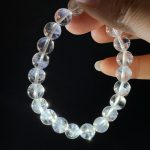Galena: Unlocking the Power of Lead Sulfide
Galena, a captivating metallic mineral, has captivated humans for centuries with its shimmering lead sulfide composition. This enigmatic crystal holds a wealth of applications, from its historical significance as a primary lead ore to its modern-day utilization in microelectronics and energy technologies.

Properties and Composition
Galena crystallizes in the cubic system, exhibiting a distinctive isometric octahedral or cubic habit. Its metallic luster and perfect cleavage along cubic planes verleihen galena a characteristic silver-gray appearance. With a Mohs hardness of 2.5, it is relatively soft and easily scratched.
Galena’s chemical composition consists primarily of lead sulfide (PbS), with traces of other elements such as silver, antimony, and iron. The presence of these impurities can influence the mineral’s physical and chemical properties, leading to variations in color, luster, and electrical conductivity.
Historical Significance
Galena’s history is intertwined with the development of human civilization. For millennia, it has been a vital source of lead, a metal employed in a vast array of applications, from batteries to paints. During the Roman Empire, galena mining flourished in Britain and Spain, where large quantities of lead were extracted for use in plumbing, construction, and warfare.
Mineralogical Significance
Galena is often associated with hydrothermal lead-zinc ore deposits, where it forms alongside other sulfide minerals such as sphalerite, pyrite, and chalcopyrite. It is a valuable indicator mineral for exploration geologists, as its presence suggests the potential for economic concentrations of lead and other metals.
Modern-Day Applications
Beyond its historical significance, galena continues to play a crucial role in various industries today.
- Electronics: Galena’s semiconducting properties make it a valuable material in microelectronics applications, including diodes, transistors, and solar cells.
- Energy: Galena is utilized as a cathode material in lead-acid batteries, providing a highly efficient and cost-effective energy storage solution.
- Jewelry: Occasionally, galena is cut and polished into cabochons or beads for decorative purposes, showcasing its unique metallic luster.
Environmental Impact
While galena has numerous beneficial applications, its mining and processing can pose environmental risks. Lead, a toxic heavy metal, can contaminate air, water, and soil if not properly managed. Therefore, strict environmental regulations and responsible mining practices are essential to mitigate the potential negative impacts.
Innovative Ideas
The unique properties of galena crystals inspire new ideas for potential applications and technological advancements:
- Biomedical: Exploring the antimicrobial properties of galena nanoparticles for potential applications in wound healing and infection control.
- Energy Harvesting: Investigating the feasibility of galena-based thermoelectric devices for efficient energy conversion.
- Photonics: Developing galena crystals as novel optical materials for applications in lasers, sensors, and telecommunications.
Useful Tables
| Property | Value |
|---|---|
| Chemical Composition | Lead Sulfide (PbS) |
| Crystal System | Cubic |
| Hardness (Mohs) | 2.5 |
| Density | 7.4 – 7.6 g/cm³ |
| World Production (2021) | Country |
|---|---|
| 3.4 million tons | China |
| 1.5 million tons | Australia |
| 1.1 million tons | United States |
| Major Applications | Industry |
|---|---|
| Lead Production | Metallurgy |
| Semiconductor Diodes | Electronics |
| Cathode Material | Batteries |
| Environmental Considerations | Impact |
|---|---|
| Lead Toxicity | Air, Water, and Soil Contamination |
| Mining and Processing | Environmental Degradation |
Effective Strategies
To harness the potential of galena crystals effectively, consider the following strategies:
- Responsible Mining: Implement sustainable mining practices to minimize environmental impacts.
- Advanced Processing Techniques: Develop innovative technologies to extract and refine galena efficiently while reducing waste.
- Collaboration and Research: Foster partnerships between industry, academia, and government agencies to advance research and development.
Frequently Asked Questions (FAQs)
Q1: What is the rarest form of galena?
A1: Galena crystals with a cubic habit are considered relatively rare compared to octahedral crystals.
Q2: Can galena be used as a gemstone?
A2: While galena is occasionally used in jewelry, its softness makes it unsuitable for everyday wear.
Q3: How is lead extracted from galena?
A3: Galena is typically concentrated through flotation and then smelted to extract lead.
Q4: What are the potential health risks associated with galena exposure?
A4: Lead exposure can cause various health issues, including neurological damage, developmental disorders, and kidney and liver problems.
Q5: How can I distinguish galena from other similar minerals?
A5: Galena’s perfect cubic cleavage, high specific gravity, and lead content can help identify it.
Q6: What is the future outlook for galena demand?
A6: Global demand for lead, and thus galena, is expected to remain stable with increasing applications in batteries and semiconductors.
Q7: Are there any alternative sources of lead other than galena?
A7: Other sources of lead include cerussite, anglesite, and pyromorphite.
Q8: What are the potential applications of galena in future technologies?
A8: Galena’s unique properties hold promise for applications in advanced materials, energy storage, and optics.




























